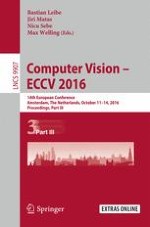The eight-volume set comprising LNCS volumes 9905-9912 constitutes the refereed proceedings of the 14th European Conference on Computer Vision, ECCV 2016, held in Amsterdam, The Netherlands, in October 2016.
The 415 revised papers presented were carefully reviewed and selected from 1480 submissions. The papers cover all aspects of computer vision and pattern recognition such as 3D computer vision; computational photography, sensing and display; face and gesture; low-level vision and image processing; motion and tracking; optimization methods; physics-based vision, photometry and shape-from-X; recognition: detection, categorization, indexing, matching; segmentation, grouping and shape representation; statistical methods and learning; video: events, activities and surveillance; applications. They are organized in topical sections on detection, recognition and retrieval; scene understanding; optimization; image and video processing; learning; action activity and tracking; 3D; and 9 poster sessions.
